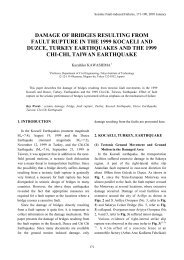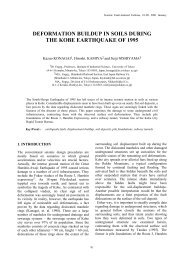simple expression of the dynamic stiffness of grouped piles
simple expression of the dynamic stiffness of grouped piles
simple expression of the dynamic stiffness of grouped piles
You also want an ePaper? Increase the reach of your titles
YUMPU automatically turns print PDFs into web optimized ePapers that Google loves.
16 SIMPLE EXPRESSIONS OF THE DYNAMIC STIFFNESS OF GROUPED PILESWith assumptions (1) and (4), <strong>the</strong>re are only two degrees <strong>of</strong> freedom for each cut-end <strong>of</strong>all slices <strong>of</strong> <strong>the</strong> soil-pile composite, namely, sway and rocking motions respectivelyu ( { u u L } Tw ( = { w w L } T) (Figuredesignated as { }= ) and { }12u N L2.2b). The rocking motions are expressed in terms <strong>of</strong> <strong>the</strong> anti-symmetric vertical motion{ w } at <strong>the</strong> outermost edge ( r = R0) <strong>of</strong> <strong>the</strong> equivalent beam with respect to <strong>the</strong> beam’scentroid. In sway motions, all np<strong>piles</strong> are equally displaced (assumption (1)), causing<strong>the</strong> bending <strong>stiffness</strong>, EI , <strong>of</strong> <strong>the</strong> equivalent beam to be simply nptimes as large as<strong>the</strong> bending <strong>stiffness</strong> <strong>of</strong> an individual pile. Assumptions (3) and (4) imply that axialmotions <strong>of</strong> <strong>the</strong> <strong>piles</strong> control <strong>the</strong> overall anti-symmetric rocking motion <strong>of</strong> <strong>the</strong> equivalentbeam just as reinforcements in a concrete beam do. Therefore, ano<strong>the</strong>r bending <strong>stiffness</strong>parameter, EI G , is introduced to describe <strong>the</strong> rocking motion <strong>of</strong> <strong>the</strong> beam. This<strong>stiffness</strong> parameter EI G is evaluated following <strong>the</strong> same procedure as that used for <strong>the</strong>evaluation <strong>of</strong> bending <strong>stiffness</strong> <strong>of</strong> a reinforced concrete beam (See APPENDIX I).Lateral external forces { p x} and moments { M } are finally described in matrixnotation in terms <strong>of</strong> {} u and { w } as specified in Equation (A12) in APPENDIX I:12w NL−1−11st column <strong>of</strong>[ ][ ] [ ][ L][ D]/R ⎤0andL D L M⎥zeros for o<strong>the</strong>r columns ⎧ u ⎫⎥⎪⎪LLLLLLLL ⎥⎨L⎬−1−1[ D] [ L] /R and [ Q] with D added to <strong>the</strong> ⎥⎪⎪ ⎭⎡⎧ ⎫⎢⎪px ⎪⎢⎨L⎬ = ⎢ LLLLLLLL⎪ M ⎪ ⎢1st row <strong>of</strong>0⎪ ⎪ ⎢⎩R0⎭ ⎢⎣zeros for o<strong>the</strong>r rowswhere, [ L ], [ D ] and [ ]M1,1upper - left corner⎥⎩w⎥⎦(2.1)Q are assembled global matrices corresponding to <strong>the</strong>individual layer parameters <strong>of</strong> 1 / hj( hj= thickness <strong>of</strong> <strong>the</strong> j-th layer), h j/ EI andG 2EI / R0hj, respectively, (See Equations (A2), (A4) and (A10) in APPENDIX IQ , respectively).defining [ L ], [ D ] and [ ]“TLEM” has been upgraded for evaluation <strong>of</strong> <strong>the</strong> behaviors <strong>of</strong> an equivalent singlebeam (Ver. 1.2). Figure 2.3 shows pile cap <strong>stiffness</strong>es k xxfor sway motions <strong>of</strong> 2×2and 3×3 steel pile groups (Table 2.1) plotted as functions <strong>of</strong> frequency. The results for<strong>the</strong> equivalent beams are shown as open circles. Each pile group is embedded in <strong>the</strong>same homogeneous soil deposit (Table 2.2) equally divided into 20 slices. Downwarddips in <strong>the</strong>se plots <strong>of</strong> k xxoccur at essentially <strong>the</strong> resonance frequencies <strong>of</strong> <strong>the</strong> soilstratum for vertical shear wave propagation. As a whole, however, every real part <strong>of</strong> <strong>the</strong>pile cap <strong>stiffness</strong>es decreases slowly as <strong>the</strong> frequency increases, whereas its imaginarypart representing <strong>the</strong> damping <strong>of</strong> a soil-pile group system shows a general upward trendto <strong>the</strong> right. The curves for <strong>the</strong> equivalent single beams agree well with rigoroussolutions from “TLEM” (Ver. 1.1).






